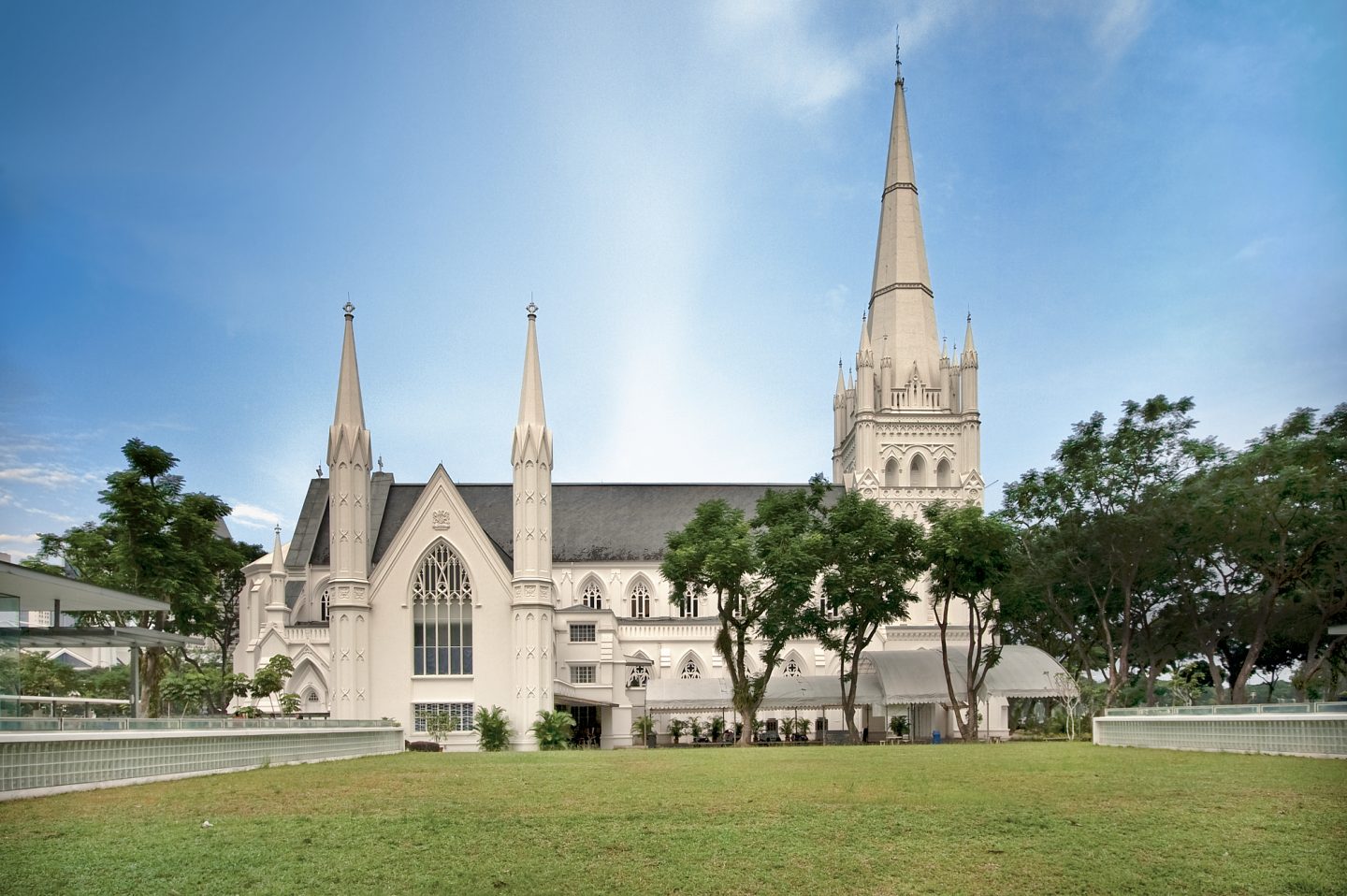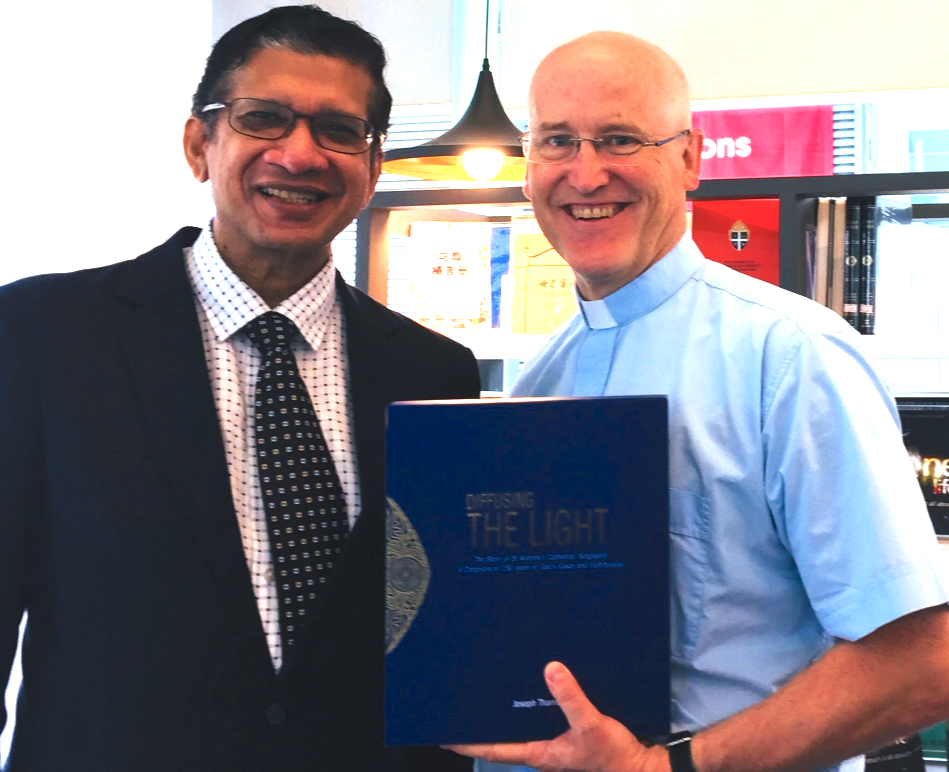200 years of divine providence: God’s “very personal involvement” in the Anglican Church
by Tan Huey Ying // November 1, 2019, 12:44 pm

St Andrew's Cathedral is the mother church of the Anglican diocese in Singapore. The first service was held in 1861. Photo courtesy of Wikipedia Commons.
In the midst of his research for a book on the history of the Anglican Church in Singapore, Professor Joseph Thambiah realised that several important books were missing from an old cabinet that dated to the immediate post-war period.
It’s a story not just of the institution, but also of the people.
But the irony, he noted, lay in the words inscribed on the cabinet: “Lest we forget”.
In the newly published The History of Anglicanism in Singapore, 1819 to 2019: The Bicentenary of Divine Providence, Prof Thambiah attempts to trace the hand of God in Singapore through the history of the Anglican Church since the first British settlements in 1819.
It explores the moments in the history of the Church in Singapore, from the spiritual revivals in the 1930s and 1970s to the present-day Anglican Church in Singapore with deaneries in the region. It is a story not just of the institution, but also of the people.
Duty-bound historian
Prof Thambiah, a spinal surgeon and clinical director at National University Hospital, is also the elected People’s Warden at St Andrew’s Cathedral, where his role provides governance support and spiritual covering for ministries.
It was this position that led him to consider it his “duty” to document the grace and faithfulness of God through the years.
The same sense of duty resulted in his first book, Diffusing the Light, published in 2012 as a coffee table book to commemorate the 150th anniversary of the consecration of St Andrew’s Cathedral.

Prof Thambiah (left) presents his first book, Diffusing the Light, to Dr David Currie, professor of theology at Gordon-Conwell Theological Seminary. Photo by David Currie.
“We cannot let these milestones pass unobserved or undocumented,” Prof Thambiah said, making reference to the memorial of 12 stones that the Israelites built after God supernaturally parted the waters of the Jordan for them to move into the Promised Land (Joshua 4:5-7).
“We cannot let these milestones pass unobserved or undocumented.”
He recalled locating a register from 1860 tucked away in a corner of the St Andrew’s Cathedral, completely forgotten. In it were the dates of the services, the languages the sermons were preached in and even the offertories collected at St Andrew’s Church Mission, the colonial church’s first outreach to the locals.
“All written in lovely longhand,” said the surgeon. “The book was so fragile that as I turned each page, I would do so gingerly and with trepidation lest I destroy a piece of history!”
His anxiety was so real that, in order to scan a page, Prof Thambiah held the scanner upside down and placed it over the delicate paper.
“When I first held it in my hands, I realised that this document had been held in hands much more pious and worthy than mine,” he added.
A mustard seed
From the dusty archives of the Anglican Diocese to the audio recordings in the National Archives, Prof Thambiah tracked down historical leads from various sources, with some facts and images emerging from countries as far as Norway.
At first, his research was mainly focused on the Cathedral but it soon became clear that although it predated the Anglican diocese, the Cathedral was only a part of a much bigger picture at play.
Raffles’ spiritual development was key to his actions in regards to the Church.
“This engagement of people in the development of the Church predated the actual construction of a physical church in 1837,” Prof Thambiah explained. “It really began when two Englishmen, Stamford Raffles and William Farquhar, first set foot on Singapore soil on January 28, 1819.”
He believes that Raffles’ spiritual development was key to his actions in regards to the Church – especially his desire to establish schools, support missionary activity and even allocate land for physical churches.
But what started out as a small mustard seed two centuries ago has now grown into a tree where many birds perch and find rest and shelter, he said.
“The Church is more than just physical buildings; it is the ecclesia, the body of faithful people. And so, I felt that Singapore’s Bicentenary was the right time to put out this second book to trace the hand of God in the nation and the Church.”
Stories of courage
It is a book of an “amazing story” that he hopes is read and re-read but Prof Thambiah is no deluded man.
“History books can often be dry and formidable tomes that often prop up other books in the library rather than being read and enjoyed,” Prof Thambiah commented rather drily about the challenges he faced in writing this history book.
“They wore their faith on their sleeves and paid for it through their suffering during the war.”
There was such a wealth of information – “all of which were interesting and relevant,” he noted – that it had taken him a fair amount of discipline and “literary surgery” to keep the book within a readable length.
“I completely left out the amazing story of the nurses and choir of St Andrew’s Cathedral who tried to flee by ship as the Japanese forces advanced,” he said.
“The ship was sunk and those who were not machine-gunned to death at sea were captured and imprisoned in hellish conditions on Banka island in Sumatra.”
But two stories in the book resonated deeply with him – the inspiring accounts of World War II heroes Elizabeth Choy and Lieutenant Andrew Ogawa, a Japanese soldier who played an unexpected role in the Singapore Church.

War heroine Elizabeth Choy (far right) at the BBC screening of documentary Return to Hell with Bishop Leonard Wilson, 24 years after the war ended. It was also the first time she would meet Lt Andrew Ogawa (not pictured). Photo from The History of Anglicanism in Singapore, 1819 to 2019.
“Their stories are inspirational – and not just for Christians. They wore their faith on their sleeves and paid for it through their suffering during the war, even though they were on opposing sides,” Prof Thambiah said. “Enemies, so to speak.”
Both served only one Master. Both endured immense emotional and spiritual pain, yet their grounding in Christ brought them through, he said: “Their stories and lives are so intricately linked that you can immediately sense the hand of God working in the situation.
“I wrote these stories and yet I cannot stop re-reading them,” he said.
For our children’s children
Two books and two hundred years’ worth of historical knowledge later, what is Prof Thambiah’s greatest takeaway?
“Through the process of reading, researching and writing, I have been humbled by just how much God is personally involving Himself in the process of growing His Church,” he said.
“A God who has been faithful in the past will continue to be faithful in the future.”
God has been using people of all nationalities and cultures as “threads” to create a marvellous tapestry of the Church in Singapore. “We will never know what the future holds but we can have faith and trust that a God who has been faithful in the past will continue to demonstrate His faithfulness in the future.
“It is learning to place our hands in His and walking in trust and confidence – much as a child would trust an earthly father who holds his hand while crossing in traffic.”
“Truly, He is the Potter and we are the clay,” he concluded.
“And in our collective journey of faith, remember to stop and build a ‘memorial of stones’ so that we, our children and our children’s children will always be able to recall the actions of a loving and faithful God.”
The History of Anglicanism in Singapore, 1819 to 2019: The Bicentenary of Divine Providence will be launched at the St Andrew’s Cathedral Cafe on Saturday, November 2, from 12 to 2pm.
We are an independent, non-profit organisation that relies on the generosity of our readers, such as yourself, to continue serving the kingdom. Every dollar donated goes directly back into our editorial coverage.
Would you consider partnering with us in our kingdom work by supporting us financially, either as a one-off donation, or a recurring pledge?
Support Salt&Light


